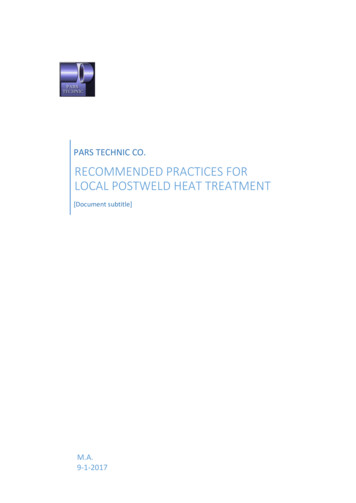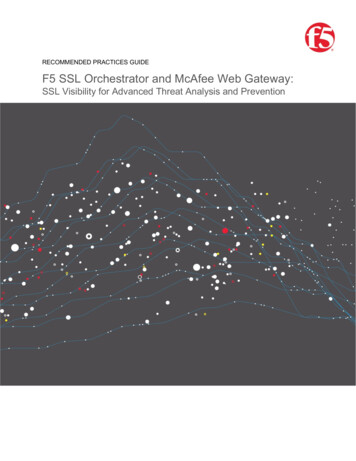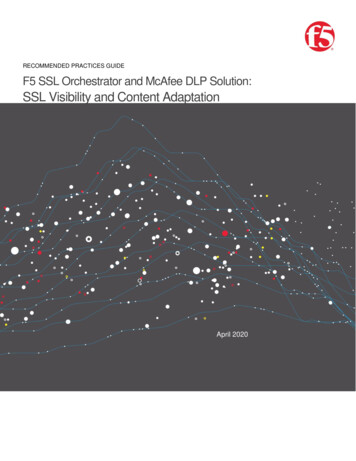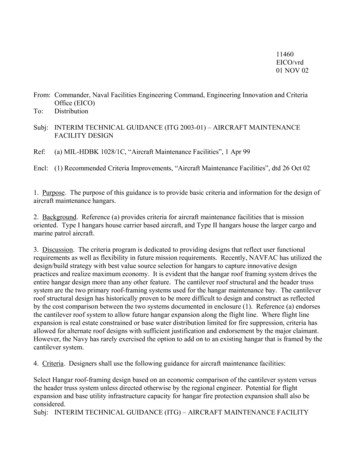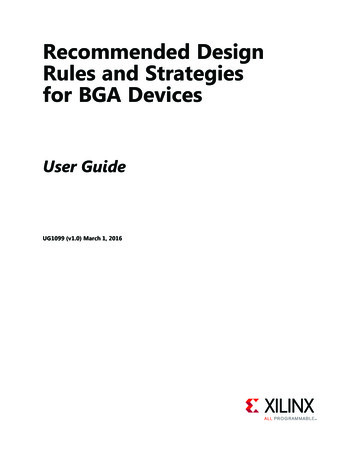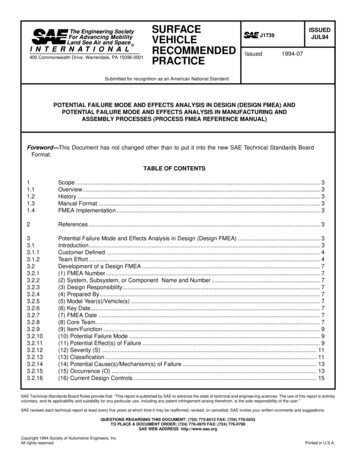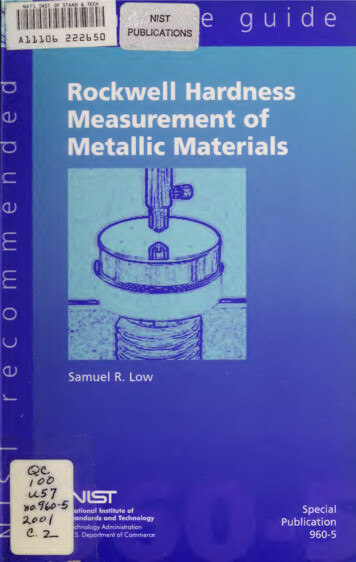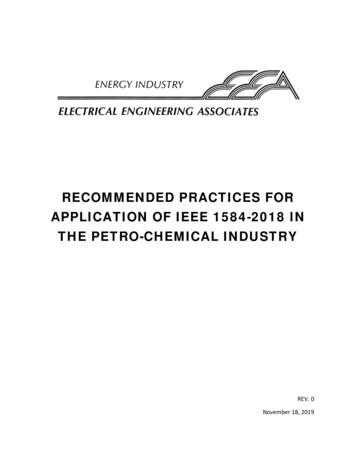
Transcription
RECOMMENDED PRACTICES FORAPPLICATION OF IEEE 1584-2018 INTHE PETRO-CHEMICAL INDUSTRYREV. 0November 18, 2019
EIEEARecommended Practices for Application ofIEEE 1584-2018 in the Petro-Chemical IndustryRev. 0DisclaimerThis document is a collection of recommended best practices for application of IEEE 1584-2018 IEEEGuide for Performing Arc-Flash Hazard Calculations. This document was assembled by a group ofvolunteers from the Energy Industry Electrical Engineering Association (EIEEA).This document is not intended to replace knowledge of IEEE 1584 and its proper application. Users ofthis document shall be knowledgeable about the latest edition of IEEE 1584 and IEEE 1584.1 for itsproper application. Users of this document must apply it and IEEE 1584 using sound engineeringjudgment.Although the EIEEA believes this document provides suitable approaches for the practical and accurateapplication of IEEE 1584-2018, the EIEEA does not guarantee the approaches described will result in“worst case” incident energy calculations. The EIEEA does not guarantee this document covers all typesof energized work tasks nor ensures safety or protection from the hazards of energized electrical work.The approaches described are expected to be a suitable approach for most real-life situations.Users of this document must ensure that the approaches recommended herein are validated andappropriate for their specific real-world electrical systems. The authors are not liable for anymisapplication nor is any guarantee implied that the approaches described are suitable for all electricalsystems.It should be noted that the methodology contained in this document considers energized work only attypical energized work locations. For example, it is expected that energized work such astroubleshooting would be performed in starter buckets in low voltage MCCs. However, it is not expectedthat energized work would be conducted on the bus bars of these low voltage MCCs. For this and otherreasons, the user must consider whether the recommended practices in this document are suitable fortheir use.Use of this document is wholly voluntary. This document is supplied “as is” and “with all faults”. In noway shall the EIEEA be liable for direct or indirect damages of any kind, however caused, arising out ofthe voluntary use of this document. Users of this document are responsible for meeting all applicablelaws and regulations in force in their jurisdiction. Use of this document does not imply compliance withapplicable local regulatory requirements.Page 2 of 16
EIEEARecommended Practices for Application ofIEEE 1584-2018 in the Petro-Chemical IndustryRev. 0TABLE OF CONTENTS1.0Introduction . 42.0Purpose . 53.0Scope . 54.0Model Input Data and Software Settings. 55.0Electrode Configuration . 76.0Gap . 87.0Electrical Equipment Enclosure Size (when applicable). 108.0Arc Duration . 109.0Working Distance . 1110.0Low Capacity 208 V Panels Fed from a Transformer . 1111.0Small Generators. 16Page 3 of 16
EIEEA1.0Recommended Practices for Application ofIEEE 1584-2018 in the Petro-Chemical IndustryRev. 0IntroductionThis document provides a practical methodology for applying IEEE 1584-2018 IEEE Guide for PerformingArc-Flash Hazard Calculations. The identified approaches will generally provide results that aremoderately conservative without requiring analysis of every possible combination of enclosure sizes,gaps, electrode configurations, etc.Electrical equipment type and configuration could result in different incident energy levels calculatedwithin the total assembly. Factors affecting these calculations include:-Available bolted fault current-Voltage-Electrode configuration-Gap between conductors-Enclosure size (when applicable)-Arcing Duration-Working DistanceIn a specific piece of electrical equipment, available bolted fault current and open circuit voltage willremain essentially the same throughout the electrical equipment (e.g. throughout a MCC). However, theother factors listed may change depending on the specific location being studied within the electricalequipment.It may be impractical to calculate incident energy for all locations in each piece of electrical equipment,for example in a low voltage MCC. Many types of electrical equipment will have varying enclosure sizes,gaps and electrode configurations depending on the specific location. This could result in a large numberof configurations to study. The recommendations in this document will help to ensure an approach thatyields moderately conservative and accurate results based on sound engineering judgment and goodengineering practices.This document also provides guidance on low capacity systems ( 240 V, 125 kVA) to help the userreduce the locations where calculations are required. See Sections 10.0 and 11.0 for more details.Many types of facilities incorporate electrical systems with voltages above 15 kV, DC systems and singlephase systems. IEEE 1584-2018 does not apply to any of these electrical systems.Page 4 of 16
EIEEA2.0Recommended Practices for Application ofIEEE 1584-2018 in the Petro-Chemical IndustryRev. 0PurposeThe purpose of this document is to provide a practical methodology for applying IEEE 1584-2018 IEEEGuide for Performing Arc-Flash Hazard Calculations. The identified approaches are expected to produceincident energy calculation results that are moderately conservative without requiring analysis of everypossible combination of enclosure sizes, gaps, electrode configurations, etc.3.0ScopeThis document applies to incident energy analysis of three-phase, 208 V to 15 kV, AC, electrical systemsin onshore oil and gas facilities. Some guidance is also provided for analysis of single-phase and DCelectrical systems. For electrical systems above 15 kV, the user should investigate the method that their modellingsoftware uses and determine its suitability. A simple 69-25 kV system was modelled using threecommon electrical modelling software packages (ETAP, SKM and EasyPower). It was found thatthe results were relatively consistent across all three and for several different optional methodswithin each software package. In general, it is believed that all three software packages will yieldvalid, conservative results when used with their default selections. DC electrical systems (if deemed required): the Doan “Maximum Power” method described in“Arc Flash Calculations for Exposures to DC Systems” (IEEE Transactions on IndustryApplications, Vol. 46., No. 6) may be used but may result in overly conservative results. See also“DC arc models and incident energy calculations” by Ammerman et al (IEEE Transactions onIndustry Applications, Vol. 46, No. 5) for more guidance to select the appropriate method for thespecific situation.4.0Model Input Data and Software SettingsIt is highly recommended that the user follows IEEE 1584-2018 section 6.2 and IEEE 1584.1-2013 forguidance on the equipment parameters required, the specific requirements for completing the incidentenergy analysis study and the recommended content for the report issued. The following guidelines areminimums. Models should be as detailed as practical for the given electrical system size and complexity. Calculations shall be based on IEEE 1584-2018. Check that this is selected in the arc flashcalculation method selection screen. Ensure electrode configuration, gap and enclosure size are all properly specified. Arc duration shall be limited to a maximum of two seconds unless there is valid reason todeviate (e.g. egress from the area is impeded) Ensure selected working distances are appropriate for each piece of equipment based on theequipment type and the tasks performed at the equipment.Page 5 of 16
EIEEARecommended Practices for Application ofIEEE 1584-2018 in the Petro-Chemical IndustryRev. 0 Cable lengths shall be included. Typical R and X values may be used. Lengths to be as close aspractical using cable schedules, field measurements, or scaled plot plans. Transformer Z% and X/R value. For systems supplied by transformers rated up to 1 MVA, motors less than 50 hp may begrouped, and motors rated 50hp and larger shall be modeled individually. For electrical systemssupplied by transformers greater than 1 MVA, motors less than 100 hp can be grouped. Forelectrical systems supplied by transformers greater than 2 MVA, motors less than 200 hp can begrouped. Utility contribution to be obtained from or confirmed by the utility company. Generators to be modeled. All appropriate scenarios shall be modelled including expected normal and abnormaloperations. Scenarios to be considered may include, but are not limited to:oNormal operating load, zero load, emergency loadoBus ties closed/open, standby/parallel generators running or not runningoUtility feeds connected or running in islanded mode.oLarge synchronous motors may also justify a scenario based on magnitude of back feed. For relays with multiple setting groups or other arc-reduction protective devices, all incidentenergy levels (including but not limited to normal and arc-reduction protection setting) shall becalculated. (i.e. with the arc reduction mode enabled and disabled) The installation being studied must be within the stated range for IEEE 1584-2018 for allparameters, including but not limited to: voltage, gap, bolted fault current, working distance andenclosure dimensions. IEEE 1584-2018 and this document assume that all equipment is installed, operated, andmaintained as required by applicable codes, standards, and manufacturers’ instructions, andapplied in accordance with the equipment’s ratings. Any deviation from these assumptions willinvalidate the incident energy calculations.Page 6 of 16
EIEEA5.0Recommended Practices for Application ofIEEE 1584-2018 in the Petro-Chemical IndustryRev. 0Electrode ConfigurationRecommendationUse Table 1 to determine the electrode configuration that is suitable for each piece of equipment. Forequipment that is not covered in Table 1, refer to guidance provided in IEEE 1584-2018 (including butnot limited to section 6.6 and Annexes C, F, and G) to determine the appropriate electrodeconfiguration.BackgroundElectrical equipment electrode configuration has a very significant effect on the incident energy levelsproduced during an arc flash incident. The location of the arc whether it is in an enclosure or in open airis also very significant. IEEE 1584-2018 requires the user to select the appropriate electrodeconfiguration from the following list:VCB – vertical conductors/electrodes inside a metal box/enclosureVCBB – vertical conductors/electrodes terminated in an insulating barrier inside a metalbox/enclosureHCB – horizontal conductors/electrodes inside a metal box/enclosureVOA – vertical conductors/electrodes in open airHOA – horizontal conductors/electrodes in open airNote that the designations of vertical and horizontal were determined based on the test set-up used indeveloping IEEE 1584-2018. In general, if the arcing electrodes point at the worker, a horizontalconfiguration should be used for the incident energy calculation. Examples of electrodes pointing at aworker include the stabs for rack-in circuit breakers or the enclosed terminals of an oil-filledtransformer. A less obvious example of where a horizontal configuration should be used for the incidentenergy calculation is if a worker was underneath bus bars that run vertically; in that case the conductorspoint at the worker and the plasma jets would be directed towards the worker.Determining open air vs enclosure is easy and quickly narrows down the choices. Selecting the correctelectrical equipment electrode configuration for an assembly can become more complicated. Based onthe content in IEEE 1584-2018, the consensus best practice from the EIEEA 1584 Working Group forselecting electrode configuration was developed and is provided in Table 1.It is worth noting that within electrical equipment enclosures, selection of HCB results in the highestcalculated incident energy levels, then usually VCBB, followed by VCB*. However, HCB is the correctelectrode configuration in only a small number of real-world applications and it results in much highercalculated incident energy than other electrode configurations. It is therefore not prudent to simplyselect HCB for all cases as this could result in a requirement for workers to wear much higher ATPV ratedPPE than is required for the actual work being performed.* - In some cases, VCB will result in a higher incident energy calculation than VCBB due todifferences in arcing currents and the time-current curve of the specific protective device that mustPage 7 of 16
EIEEARecommended Practices for Application ofIEEE 1
02.03.2020 · The purpose of this document is to provide a practical methodology for applying IEEE 1584-2018 IEEE Guide for Performing Arc-Flash Hazard Calculations. The identified approaches are expected to produce incident energy calculation results that are
